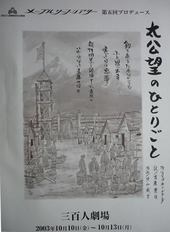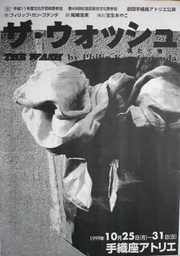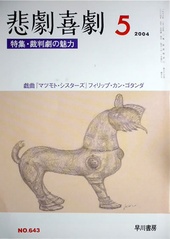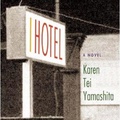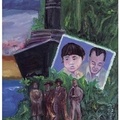>>その1
父の姿を通して日系人の一生を紡ぐ
「太公望のひとりごと」は、2003年10月に、劇団メイプル・リーフ・シアターによって文京区の三百人劇場(2006年閉館)で上演された。アメリカでの初演は1981年である。私は、1984年、ロサンゼルスのEWPによる公演と、この三百人劇場での日本公演を観た。
この戯曲は、作者の父、ウィルフレッド・イツタ・ゴタンダをモデルとした作品で、主人公イツタ・マツモトの青年期から老年期に至る人生を「魚をとる」「魚を洗う」「魚を料理する」「魚を食べる」そして最後にまた「魚をとる」に戻るという、ユニークなタイトルの場に分けて描いている。
ハワイで生まれ育った釣り好きのイツタは本土で医者になり、ミチコと結婚する。戦時中は収容所に送られ、戦後子供をもうけるが、子供たちと世代間のギャップを感じるようになる。日本人でない女性とデートをしたり、法学を捨てて作家になる子供たちが理解できず、彼らとのコミュニケーションを断ってしまう。ある日、突然妻のミチコが脳腫瘍で他界。孤独の中、最後の場でイツタは夢の中で自分の両親と妻に再会する、という物語だ。だが、描いているのはイツタのことばかりではない。
第4場で、妻のミチコが言う。「28年間あなたの食事をつくり、服の洗濯をし、あなたの子供を産んだ。あなたは自分の人生でやりたいことがあった。夢を持っていた。その夢が遠くにいきかけたとき、あなたは嘆き、私はあなたをなぐさめた。夢が叶ったとき私はうれしかったけれど、あなたは一度も私に感謝してくれなかったよね。2人の息子もそれぞれやりたいことを持っている。夢を抱いている。でも、私の夢はどうなっているの。私がしたいことがあったらどうなの」
このような、自立を求める2世女性像は、「ザ・ウォッシュ」に引き継がれている。
自立する妻と身勝手な夫
「ザ・ウォッシュ」は、1999年に日本の劇団手織座によって同劇団のスタジオで上演された。アメリカでの初演は1985年である。
この作品は、ゴタンダの身の回りにおきた二つの実話をもとにして書かれた。一つは夫と離婚し、他の男性と新しい関係を築いたある2世の女性、もう一つは離婚後もかつての妻のところに芝を刈りにやってくるある2世の作家である。ゴタンダは後者の話に出てくる芝を洗濯に置き換えて、日系老夫婦の物語を書いた。
日系女性のマシは、家父長的な性格を持ち、文句ばかり言っている夫ノブから離れ、一年以上、別居状態を続けている。だが、その間マシはずっと洗濯をするためにノブの家を訪れていた。やがて、マシにはサダオという新しい恋人ができ、釣りを通して愛情が深まっていく。マシは離婚を決意する。ノブは承服しないが、決意の固いマシを前にして、なすすべがない。ノブは子供とも問題を抱えている。黒人と結婚し、黒人との子供が生れた娘をなかなか許すことができない。自立心の強い女性をテーマに描いているが、自己中心的なノブもまた、ゴタンダは愛情を込めて描いている。
この作品は、1988年にマイケル・トシユキ・ウノという日系監督によって映画化された。老夫婦の役はノブ・マッカーシーとマコ・イワマツという、今はどちらも故人となってしまったが、日系を代表する役者が演じた。私はこの映画を1988年にロサンゼルスのリトル・トーキョーで観たが、内容とは別に、役者がすべて日系アメリカ人であることと、マコとマッカーシーのベッドシーンがあることが話題になっていた。
描かれることのない戦後の日系社会を追求する
「マツモト・シスターズ」は、2004年6月から7月にかけて、新宿の紀伊国屋サザンシアターで劇団民藝によって上演された。私が観にいった日は、台風が日本に上陸した日で、強風で壊れそうになった傘を持って劇場に向かったことを今でもよく覚えている。
公演に先駆けて、『悲劇喜劇』の同年5月号に、吉原豊治による翻訳台本が掲載された。上演前に台本が演劇誌に載るというのも異例だが、日系アメリカ人の翻訳台本が活字になったのは、この前にも後にも例がない。快挙といっていいだろう。
この作品は、1945年の晩秋、アーカンソー州の日系人強制収容所からカリフォルニア州のストックトンに戻った三姉妹を描いた作品である。戯曲の冒頭に、キャサリーンへ、と但し書きがあるように、作者の母をモデルとしているが、チェーホフの『三人姉妹』と谷崎潤一郎の『細雪』にも間接的に影響を受けている。
作品の背景は戦争の直後だが、ゴタンダはこの時代に強い関心があるという。日系人が収容所を出た後、彼らがアメリカ社会にどう再編入されていったかについて、文学ではまだ十分描かれていない。また、日系社会内部の階層構造や、日系社会と他のより大きな文化との関係に興味があり、この作品ではそれらのテーマを追求した。
主人公は長女の2世、グレース。帝国大学出身の夫ヒデオは元大学講師で、今は新聞の発行を夢見ている。ヒデオは貧しい家庭に生まれたため、資産のあるグレースを結婚相手として選んだ。しかし、ストックトンにあるグレースの家は銀行の手に渡っていた。収容所にいるとき、彼女の父親が親しくしていた友人にだまされ、子供たちに内緒で家を売却していたのだ。資産を亡くしたグレースは、資産のない今の自分とこれからも生活を共にしていくのかと夫に迫る。戯曲の中で最も緊張感が高まった場面だった。
三人姉妹というのは絵になる。芝居を見ながらそう感じた。だが、長女と次女の夫と、三女の恋人の3人の男たちもまた、絵になっていた。診療所を開業したいと思っている次女の夫ボーラとヒデオとの確執。ボーラは帝国大学出の義兄にいつも見下されている気がしていた。ヒデオの無口で人付き合いの悪いところも気にいらなかった。でも、資産がなく、また収容所で親米派の義父と対立していたヒデオは、生きる術として無口にならざるを得なかったのである。
最後の幕で、姉妹の父親が銀行に売ったお金をどう活用しようかという話になる。それを取りまとめたのが、今まで無口で生きてきたヒデオだった。売りに出されていたホテルを買い取り、そこに新聞社の社屋と診療所をつくろうという計画で、皆賛同した。
こうして、明るい希望が見えたところで幕が閉じた。収容所後の日系人の話ではあったが、グレースを演じた樫山文枝の「一番客席に届けたいのは、信頼や支えあうという感情」(朝日新聞朝刊 2004年6月19日)が戯曲全体から伝わってきた。
ゴタンダのそれまでの作品以上に人物の感情が深く掘り下げられていると感じた。作家自身も進化、そして深化しているのだろう。
荒天にもかかわらず、劇場の客席は7~8割うまっていた。劇団の力か、主演・樫山の力か。いずれにせよ、日系アメリカ人の地味な芝居を多くの日本人が見てくれるのは私としてはうれしいことだった。
※本文中に引用した詩・エッセイの翻訳はすべて筆者による。
*本稿は、時事的な問題や日々の話題と新書を関連づけた記事や、毎月のベストセラー、新刊の批評コラムなど新書に関する情報を掲載する連想出版のWebマガジン「風」 のコラムシリーズ『二つの国の視点から』第5回目からの転載です。
© 2009 Association Press and Tatsuya Sudo


